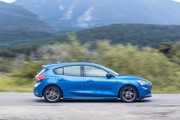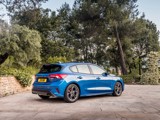Review
It’s a headline-grabbing claim: “This is the best car we’ve ever built.”
That’s head of fleet Owen Gregory’s view of the new Ford Focus. Can the car live up to such a billing?
In many ways, yes, but it does depend on your criteria and priorities. It’s certainly the best Ford for connectivity, technology and safety. Arguably, it also offers the best overall package.
Handling, as with all Focuses since the original in 1998, is crisp and precise, ride is smooth and the grip is outstanding. The Fiesta ST is probably a better driver’s car, though. Nevertheless, the Focus is agile and responsive, equally at home around town, on motorways or zipping around rural roads.
This car is one of 300+ models available to test drive at the UK’s largest and most comprehensive test-driving event for fleet decision makers
At Company Car in Action (CCIA) you can:
- Meet the major fleet brands at Milbrook Proving Ground
- Evaluate an unrivalled range of models with back-to-back comparative test drives on 4 unique purpose-built test circuits
- Meet suppliers and discuss your requirements for the future
- Enhance your knowledge of low-emissions vehicles and learn about best practice with panels of experts
June 12-13, 2019 | Milbrook Proving Ground | ccia@bauermedia.co.uk
Styling, as with each previous generation, has undergone a revolution. Some love it, some don’t. We think it looks great from the front, but much less so from the rear.
Interior quality is good – a mix of smooth/hard plastics and soft materials, plus half the number of physical buttons for an improved layout. It’s up with the best-in-class.
The Focus makes outstanding use of its space with greater room for front and rear passengers (and boot space) thanks to a longer wheelbase. Shorter overhangs mean exterior dimensions are unchanged.
Away from the passionate proclamations, something more tangible has happened from a fleet perspective. Ford has reduced the P11D price on key models – by £2,300 on the (reintroduced) entry level Style, now from £17,730, and by £850 on the fleet favourite Zetec, at £19,100. The move has positive implications for drivers on BIK and fleets on national insurance/corporation tax.
The Titanium is the same (£21,350), but higher levels of standard equipment offer greater value, says Ford.
All models come as standard with emergency and post-collision braking, lane-keeping warning/aid, intelligent speed assist, hill start assist, electronic stability control and 4.2-inch colour display.
Zetec adds Ford Sync 3 digital radio with 6.5-inch touchscreen, cruise control and front fog lamps with cornering function; Titanium adds LED rear lights, folding door mirrors, front/rear parking sensors, rain-sensing wipers, heated front seats, dual-zone aircon, sat-nav and keyless entry/start.
In addition to the two key fleet trims, the £21,370 ST-Line, with its 10mm lowered sports-tuned chassis, unique grille and body styling kit, will appeal to drivers looking for a sportier model. It is also the residuals champion, so fleets also have something to love.
Topping the range is the £25,250 Vignale, with head-up display for the first time on a Ford in Europe, plus active park assist which can now handle gradients up to 12 degrees and accommodate curb parking where allowed.
As well as price reductions, updated and new engines have lower CO2 emissions/better fuel efficiency than those they replace – even when comparing their WLTP CO2MPAS rating to the old engines’ NEDC – while residuals are up 25% over three years/60,000 miles (on average from £6,000 to £7,500).
This triple whammy will result in a sizeable reduction in wholelife costs, making the car a highly attractive proposition for fleets, who will account for half of sales.
Pricing guides usually give new cars an RV boost, but underpinning this is the fact that Ford plans to dramatically cut the volume going to rental from 23% to just 8%.
However, it expects total volumes to remain broadly level with the outgoing model, which means more cars going to true fleet and retail.
The Focus will be launched as five-door hatchback this month, with the new 1.5-litre EcoBlue diesel (70% of corporate sales) and the upgraded 1.0-litre Ecoboost (30%).
The 95PS diesel emits 91g/km, the 120PS 94g/km, both on 16-inch wheels. The petrol (85PS, 100PS and 125PS) with cylinder deactivation emits from 107g/km.
The 125PS petrol has bags of power, particularly at higher revs, while the 120PS diesel is punchy at low revs and remains the best option for higher mileage drivers.
Noise levels – engine, road and wind – are noticeably reduced thanks to improved damping and a stiffer body.
Around 20% of the model mix will be the new eight-speed automatic with rotary dial and paddles, a £1,350 premium; the balance will be the six-speed manual.
The wagon (estate) will arrive in October, together with a 2.0-litre diesel (112g/km) and 1.5-litre petrol (121g/km), while the Focus Active, 30mm higher than the standard car with its own grille, is due in early 2019.
A mild hybrid option will follow while plug-in hybrid/electric vehicle versions could come in 2020.
The best Ford ever? Perhaps a touch hyperbolic, but it’s undeniably the best Focus ever.
Specification shown for: Ford Focus hatch 1.5TDCi 120 Zetec
Model pictured: New Ford Focus ST Line
Specs
| Manufacturer | Ford |
| Model | Focus |
| Specification | Focus Hatch 5Dr 1.5 EcoBlue 120 DPF SS €6 Zetec 6Spd 18.75MY |
| Model Year | 0.00 |
| Annual VED (Road tax) | £0 |
| BIK List Price | £20,570 |
| CO2 | 93g/km |
| BIK Percentage | 23% |
| Insurance Group | N/A |
| CC | N/A |
| Fuel Type | Diesel |
| Vehicle Type | Small family car |
| Luggage capacity (Seats up) | 5litres |
Running Costs
| P11D | £20,570 |
| Insurance group | N/A |
| Fuel Type | Diesel |
| Cost per mile | 59.82ppm |
| Fuel | 7.28ppm |
| Depreciation | 50.48ppm |
| Service maintenance and repair | 2.06ppm |
Rivals
Info at a glance
-
P11D Price
£20,570
-
MPG
80.7 -
CO2 Emissions
93g/km -
BIK %
23% -
Running cost
3 Year 60k : N/A 4 Year 80k : N/A -
Fuel Type
Diesel




















 Diesel
Diesel

















